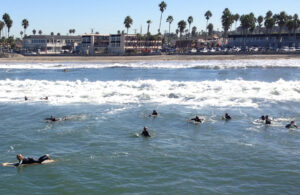Study links HF183 fecal marker in runoff to illness risks

SCCWRP and its partners have completed a study establishing the inflection point, or threshold, at which levels of the fecal contamination marker HF183 in wet-weather runoff correspond to an elevated illness risk for people swimming in contaminated receiving waters – a finding that paves the way for a follow-up investigation examining what actions are appropriate for managers to take based on the level of HF183 measured.
The three-year study, conducted in partnership with the Southern California Stormwater Monitoring Coalition (SMC) and described in a pair of journal manuscripts published in February and April, found that 100 gene copies of HF183 in a 100-mL sample is the threshold at which a water body with contaminated stormwater is deemed unsafe to swim in.
By contrast, an estimated 557 gene copies per 100-mL sample are present on average during wet weather in southern California coastal watersheds. What this means is that wet-weather runoff in Southern California, on average, would need to be diluted about 5.5-fold to fall within the safe-to-swim range established by the U.S. Environmental Protection Agency.
Translated into illness risks, the fecal contamination levels that researchers measured in Southern California runoff correspond to a predicted average of 190 gastrointestinal illnesses per 1,000 swimmers. The EPA-approved health risk threshold is 32 illnesses per 1,000.
These insights have helped close a critical knowledge gap about the illness risks associated with beachgoers and others who inadvertently ingest water containing fecal contamination.
For more than a decade, managers have been measuring HF183 in wet-weather runoff to detect human-specific sources of fecal contamination. Unlike other commonly measured indicators of fecal contamination like Enterococcus and E. coli, HF183 can distinguish human fecal contamination from other animal sources. Human sources present a public health risk, whereas most other animal sources do not.
The challenge is that when managers detect HF183 in runoff, they historically have had no context for understanding what degree of illness risk the HF183 levels represent for humans who are exposed to contaminated runoff in receiving water bodies downstream – limiting managers’ ability to take follow-up actions based on based on HF183 measurements.
During the follow-up investigation that will launch this summer, researchers will facilitate the deliberations of a management advisory committee that will develop recommendations for how to apply the HF183 threshold in a water-quality management context. The committee, which is comprised of both stormwater regulated and regulatory parties as well as public health departments and an environmental advocacy organization, will explore what actions are appropriate for managers to take upon measuring HF183 exceedances in runoff.
The committee’s recommendations are expected in summer 2027.
HF183 is a specific fragment of genetic material found in a ubiquitous human gut bacterium known as Bacteroides.
Although the HF183 thresholds derived by SCCWRP and its partners are not the first estimates of illness risks based on HF183 measurements, the prior studies were desktop modeling exercises that did not involve field data collection; the earlier studies also were focused on sewage spills instead of contaminated wet-weather runoff.
During the SCCWRP-led study, researchers collected wet-weather data from 31 watershed sites across coastal Southern California, and took advantage of recent advances in droplet digital PCR (polymerase chain reaction) technology to directly measure six common pathogens, including human norovirus, adenovirus, Campylobacter, and Salmonella. Health risk modeling was then used to derive the HF183 thresholds.
For more information, contact Dr. Joshua Steele.
More news related to: Microbial Risk Assessment, Microbial Water Quality, Southern California Stormwater Monitoring Coalition, Top News